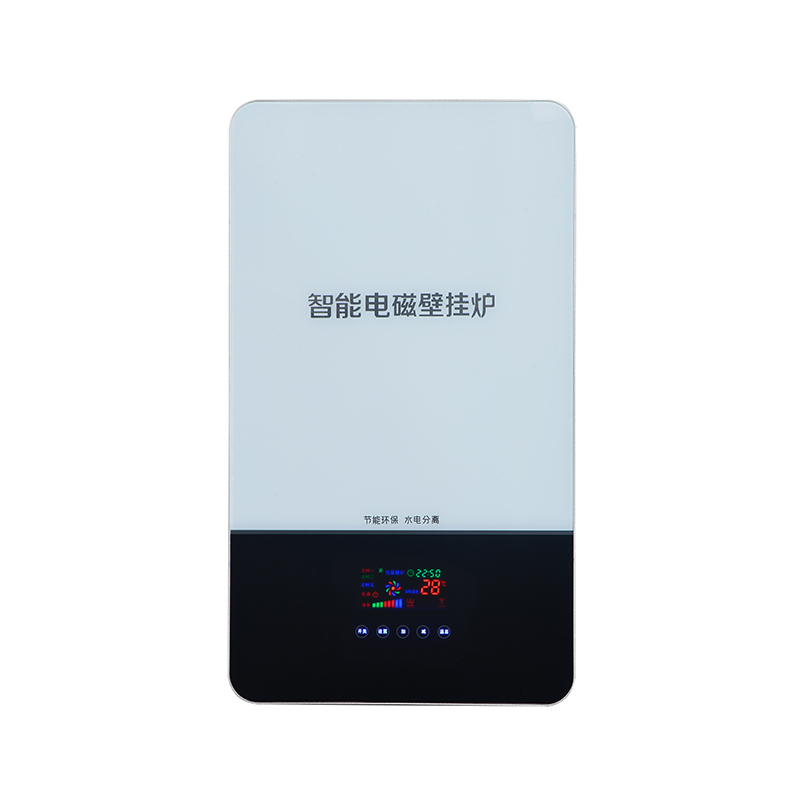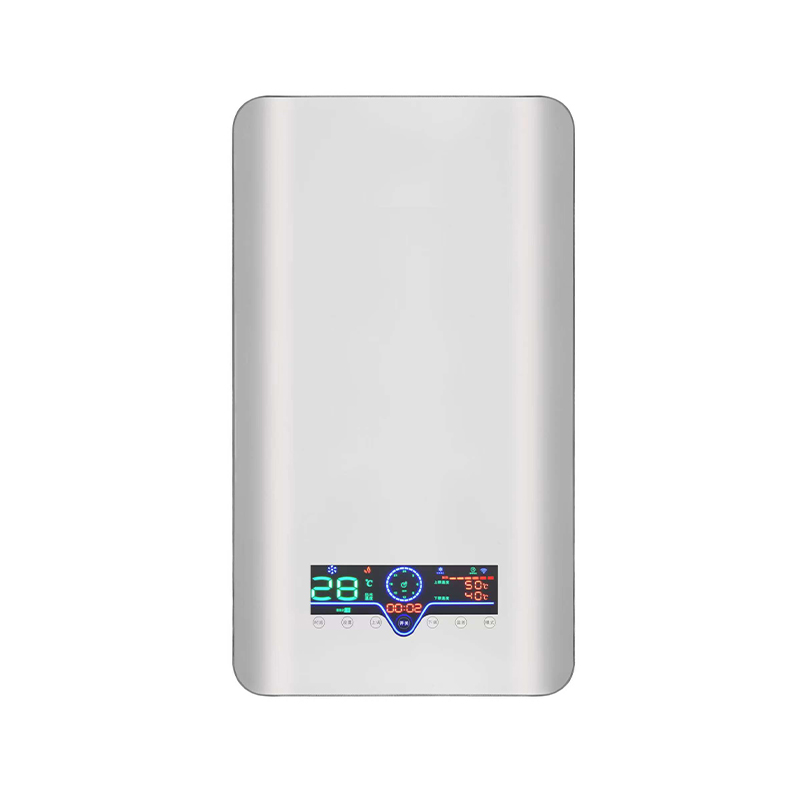How does intelligent variable frequency technology enable electromagnetic heating furnaces to provide on-demand heating?
Release Time : 2025-09-18
In modern home heating systems, energy conservation, comfort, and intelligence have become core user demands. Traditional electric or gas wall-mounted boilers often operate at full power with frequent starts and stops, resulting in high energy consumption and large temperature fluctuations, impacting the user experience. Electromagnetic heating furnaces equipped with intelligent variable frequency technology are revolutionizing this situation through their precise power regulation capabilities. They dynamically adjust heating intensity based on actual heating demand, achieving "on-demand heating" while ensuring comfort while significantly reducing energy consumption, truly achieving "just what you need, just what you need."
1. Limitations of Traditional Heating Modes: High Energy Consumption and Extensive Temperature Control
Traditional electric heating equipment typically uses a "fixed-frequency" operating mode, meaning it operates at full rated power and automatically shuts down when the water temperature reaches the set point, restarting after the water temperature drops a certain amount. This "on-off" cycle has significant drawbacks: First, frequent starts and stops waste energy and circuit shock; second, large water temperature fluctuations result in inconsistent heating or hot water, making the heating or hot water uncomfortable; third, even when only a small amount of supplemental heat is needed, the equipment still operates at full power, resulting in a "big horse pulling a small cart" of energy waste. This mode is particularly energy-inefficient during spring, autumn, and nighttime periods when heat demand is low.
2. The Core of Intelligent Frequency Conversion: Dynamic Adjustment of Heating Power
The intelligent frequency conversion electromagnetic heating furnace utilizes advanced IGBT frequency conversion modules and a microcomputer control system, eliminating traditional on-off heating logic. Its operating principle is to collect real-time data on multiple dimensions, such as inlet and outlet water temperature, room temperature, and water flow rate. The built-in MCU analyzes and calculates this data to dynamically adjust the operating frequency and current of the electromagnetic heating coil, thereby achieving stepless adjustment of heating power. For example, when the system is initially started or when there are large temperature fluctuations, it automatically outputs high power at 90%-100% for rapid temperature increase. As the temperature approaches the set point, it gradually reduces the power to a medium-low level of 30%-50% for precise supplemental heating. During the heat preservation phase, it maintains the water temperature at a low power level of only 10%-20%. This entire process is smooth and continuous, avoiding drastic fluctuations.
3. On-demand heating: Precisely matching actual heat load
The essence of "on-demand heating" is to dynamically balance the device's output power with the user's actual heat demand. Intelligent inverter technology achieves this goal through the following methods:
Automatic adjustment based on room temperature: Working with a room thermostat or Wi-Fi smart module, the system can sense room temperature fluctuations. When the room temperature approaches the set point, it automatically reduces heating power to prevent overheating. When someone moves around or opens a window to dissipate heat, it promptly increases power to quickly restore a comfortable temperature.
Intelligent learning based on water usage habits: Some high-end models feature AI learning capabilities that track users' daily hot water usage patterns, such as bathing and cooking. This allows for preheating before peak hours and energy-saving standby during off-peak hours, optimizing energy distribution.
Multi-zone independent temperature control: In a dual-demand system of floor heating and domestic hot water, variable frequency technology prioritizes instantaneous heating of domestic hot water while simultaneously providing stable, low-power heating for the floor heating, achieving efficient multi-tasking coordination.
4. Dual Improvements in Energy Saving and Comfort
The most direct benefit of intelligent variable frequency technology is significant energy savings. By avoiding frequent starts and stops and full power consumption, overall energy efficiency can be improved by 20%-35%. Furthermore, water temperature output is stable, and the floor heating heats up evenly, providing instant hot water and a constant, comfortable temperature, eliminating the annoying "hot and cold" sensation. Furthermore, variable frequency operation reduces electromagnetic noise and thermal stress, extending the lifespan of core components such as the heater, water pump, and circuit boards, and improving overall equipment reliability.
5. Intelligent Interaction for Whole-House Energy Management
Modern intelligent variable frequency electromagnetic heating furnaces can also be integrated into home energy management systems, linking with solar energy, energy storage batteries, and photovoltaic systems. Automatic heating and heat storage are implemented during low electricity price periods, while reducing electricity consumption during peak hours, further reducing operating costs. Users can remotely monitor energy consumption, set modes, and receive fault alerts via a mobile app, achieving truly smart energy management.
Smart inverter technology empowers electromagnetic heating furnaces with human-like capabilities: "perception, analysis, and adjustment," transforming them from mechanical heaters into intelligent thermal stewards. Through precise power control, they deliver true on-demand heating, balancing energy conservation, comfort, and durability. Against the backdrop of rising energy costs and heightened environmental protection requirements, smart inverter electromagnetic heating furnaces are becoming a mainstream choice for clean home heating in the future.
1. Limitations of Traditional Heating Modes: High Energy Consumption and Extensive Temperature Control
Traditional electric heating equipment typically uses a "fixed-frequency" operating mode, meaning it operates at full rated power and automatically shuts down when the water temperature reaches the set point, restarting after the water temperature drops a certain amount. This "on-off" cycle has significant drawbacks: First, frequent starts and stops waste energy and circuit shock; second, large water temperature fluctuations result in inconsistent heating or hot water, making the heating or hot water uncomfortable; third, even when only a small amount of supplemental heat is needed, the equipment still operates at full power, resulting in a "big horse pulling a small cart" of energy waste. This mode is particularly energy-inefficient during spring, autumn, and nighttime periods when heat demand is low.
2. The Core of Intelligent Frequency Conversion: Dynamic Adjustment of Heating Power
The intelligent frequency conversion electromagnetic heating furnace utilizes advanced IGBT frequency conversion modules and a microcomputer control system, eliminating traditional on-off heating logic. Its operating principle is to collect real-time data on multiple dimensions, such as inlet and outlet water temperature, room temperature, and water flow rate. The built-in MCU analyzes and calculates this data to dynamically adjust the operating frequency and current of the electromagnetic heating coil, thereby achieving stepless adjustment of heating power. For example, when the system is initially started or when there are large temperature fluctuations, it automatically outputs high power at 90%-100% for rapid temperature increase. As the temperature approaches the set point, it gradually reduces the power to a medium-low level of 30%-50% for precise supplemental heating. During the heat preservation phase, it maintains the water temperature at a low power level of only 10%-20%. This entire process is smooth and continuous, avoiding drastic fluctuations.
3. On-demand heating: Precisely matching actual heat load
The essence of "on-demand heating" is to dynamically balance the device's output power with the user's actual heat demand. Intelligent inverter technology achieves this goal through the following methods:
Automatic adjustment based on room temperature: Working with a room thermostat or Wi-Fi smart module, the system can sense room temperature fluctuations. When the room temperature approaches the set point, it automatically reduces heating power to prevent overheating. When someone moves around or opens a window to dissipate heat, it promptly increases power to quickly restore a comfortable temperature.
Intelligent learning based on water usage habits: Some high-end models feature AI learning capabilities that track users' daily hot water usage patterns, such as bathing and cooking. This allows for preheating before peak hours and energy-saving standby during off-peak hours, optimizing energy distribution.
Multi-zone independent temperature control: In a dual-demand system of floor heating and domestic hot water, variable frequency technology prioritizes instantaneous heating of domestic hot water while simultaneously providing stable, low-power heating for the floor heating, achieving efficient multi-tasking coordination.
4. Dual Improvements in Energy Saving and Comfort
The most direct benefit of intelligent variable frequency technology is significant energy savings. By avoiding frequent starts and stops and full power consumption, overall energy efficiency can be improved by 20%-35%. Furthermore, water temperature output is stable, and the floor heating heats up evenly, providing instant hot water and a constant, comfortable temperature, eliminating the annoying "hot and cold" sensation. Furthermore, variable frequency operation reduces electromagnetic noise and thermal stress, extending the lifespan of core components such as the heater, water pump, and circuit boards, and improving overall equipment reliability.
5. Intelligent Interaction for Whole-House Energy Management
Modern intelligent variable frequency electromagnetic heating furnaces can also be integrated into home energy management systems, linking with solar energy, energy storage batteries, and photovoltaic systems. Automatic heating and heat storage are implemented during low electricity price periods, while reducing electricity consumption during peak hours, further reducing operating costs. Users can remotely monitor energy consumption, set modes, and receive fault alerts via a mobile app, achieving truly smart energy management.
Smart inverter technology empowers electromagnetic heating furnaces with human-like capabilities: "perception, analysis, and adjustment," transforming them from mechanical heaters into intelligent thermal stewards. Through precise power control, they deliver true on-demand heating, balancing energy conservation, comfort, and durability. Against the backdrop of rising energy costs and heightened environmental protection requirements, smart inverter electromagnetic heating furnaces are becoming a mainstream choice for clean home heating in the future.





